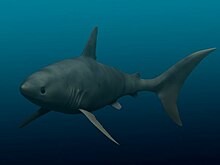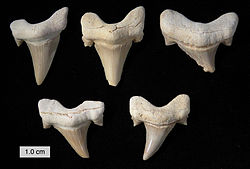Otodus
| Otodus | |
|---|---|

| |
| Reconstructed jaws of a Paleogene Otodus (O. obliquus) | |

| |
| Reconstructed jaws of a Neogene Otodus (O. megalodon) | |
| Scientific classification | |
| Domain: | Eukaryota |
| Kingdom: | Animalia |
| Phylum: | Chordata |
| Class: | Chondrichthyes |
| Subclass: | Elasmobranchii |
| Subdivision: | Selachimorpha |
| Order: | Lamniformes |
| Family: | †Otodontidae |
| Genus: | †Otodus Agassiz, 1843 |
| Type species | |
| †Otodus obliquus Agassiz, 1838
| |
| Species[1][2] | |
Species pending reassessment
| |
| Synonyms[3] | |
| |

Otodus is an
Description
All species are known from their

Size estimation
The fossils of Otodus sharks indicate that they were very large macro-predatory sharks.[7] The largest known teeth of O. obliquus measure about 104 millimetres (4.1 in) in height.[8] The vertebral centrum of this species are over 12.7 cm (5 inch) wide.[7] Scientists suggest that O. obliquus would have measured about 8–9 metres (26–30 ft) long.[7][9] Other species were much larger, with O. auriculatus, O. angustidens and O. chubutensis being estimated to have reached maximum body lengths of 9.5 metres (31 ft), 11–12 metres (36–39 ft) and 13.5 metres (44 ft), respectively.[9][10] The largest species, O. megalodon, was estimated to have reached a maximum body length of approximately 20.3 metres (67 ft).[11]
Growth and reproduction
Comparative studies of the centrum radii and growth rings on the vertebrae of O. obliquus and the extant great white shark through X-rays have concluded that the sizes of the vertebrae at birth are similar, meaning that the offspring of both species would have the same size (between 1.1 and 1.6 m (3.6 and 5.2 ft) in length); they also revealed that they grew at the same rate until reaching 10 years of age, during which O. obliquus would have become sexually mature and attained a growth rate faster than that of the extant great white shark. A sexually mature individual of O. obliquus would have measured about 4 m (13 ft) long. Like the extant great white shark, it is likely that males could have reached sexual maturity earlier than females.[12][13]
O. angustidens also had a faster growth rate than the extant great white shark, while O. auriculatus and the extant great white shark had a similar growth rate. O. megalodon had a much faster growth rate (nearly two times that of the extant great white), but likely had an extremely delayed sexual maturity based on the result of the study that the slowing or cessation of somatic growth in megalodon occurred around 25 years of age.[12]
Like contemporaneous sharks, at least two species of Otodus (O. angustidens and O. megalodon) made use of nursery areas to birth their young in, specifically warm-water coastal environments with large amounts of food and protection from predators.[14][10] A possible reproduction area of O. obliquus has been discovered in the Ganntour basin, Morocco.[13]
Distribution
Otodus had a worldwide distribution, as fossils have been excavated from Africa, Asia, Europe, North America, South America, Caribbean and Australia.[6][15]
Diet
Otodus was likely the
There is also potential evidence that Otodus hunted raptorial sperm whales; a tooth belonging to an undetermined 4 m (13 ft) long physeteroid closely resembling those of Acrophyseter discovered in the Nutrien Aurora Phosphate Mine in North Carolina suggests that a megalodon or O. chubutensis may have aimed for the head of the sperm whale in order to inflict a fatal bite, the resulting attack leaving distinctive bite marks on the tooth. While scavenging behavior cannot be ruled out as a possibility, the placement of the bite marks is more consistent with predatory attacks than feeding by scavenging, as the jaw is not a particularly nutritious area for a shark to feed or focus on. The fact that the bite marks were found on the tooth's roots further suggest that the shark broke the whale's jaw during the bite, suggesting the bite was extremely powerful. The fossil is also notable as it stands as the first known instance of an antagonistic interaction between a sperm whale and an otodontid shark recorded in the fossil record.[17]
Evolution
It is widely believed that the genus originates from a lineage of sharks belonging to the genus
See also
- Prehistoric fish
References
- PMID 25332848.
- PMC 6789557.
- ISBN 978-0-471-25031-9.
- ^ Shimada, K. (2022). "Phylogenetic affinity of the extinct shark family Otodontidae within Lamniformes remains uncertain - Comments on "List of skeletal material from megatooth sharks (Lamniformes, Otodontidae)" by Greenfield" (PDF). Paleoichthys. 6: 1–5.
- ^ Greenfield, T. (2022). "Additions to "List of skeletal material from megatooth sharks", with a response to Shimada (2022)" (PDF). Paleoichthys. 6: 6–11.
- ^ a b c d Bourdon, Jim, Otodus
- ^ ISBN 0-9719477-0-8
- ^ "Huge OTODUS OBLIQUUS shark tooth with pathology". Archived from the original on July 22, 2011. Retrieved May 21, 2011.
- ^ PMID 35731884.
- ^ doi:10.26879/1148.
- doi:10.26879/1140.
- ^ a b Ehret D.J. (2010). "CHAPTER 5 – MACROEVOLUTION, AGE, AND GROWTH DETERMINATION OF THE MEGATOOTHED SHARKS (LAMNIFORMES: OTODONTIDAE)". Paleobiology and taxonomy of extinct lamnid and otodontid sharks (Chondrichthyes, Elasmobranchii, Lamniformes) (PDF). pp. 100–136.
- ^ a b Biton-Porsmoguer, S. (2017). "Posible área de reproducción de Otodus obliquus (Lamniformes: Lamnidae) del Paleoceno en la cuenca de Ganntour (Marruecos)".
- PMID 20479893.
- .
- ^ Aguilera O.; Augilera E. R. D. (2004). "Giant-toothed White Sharks and Wide-toothed Mako (Lamnidae) from the Venezuela Neogene: Their Role in the Caribbean, Shallow-water Fish Assemblage". Caribbean Journal of Science. 40 (3): 362–368.
- ^ STEPHEN J. GODFREY; JOHN R. NANCE; NORMAN L. RIKER (2021). "Otodus-bitten sperm whale tooth from the Neogene of the Coastal Eastern United States" (PDF). Acta Palaeontologica Polonica. 66 (3): 599–603.
- PMID 29333348.
- S2CID 89080495.
